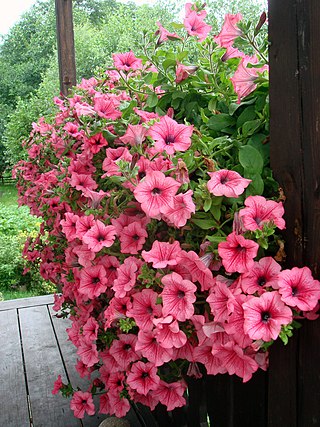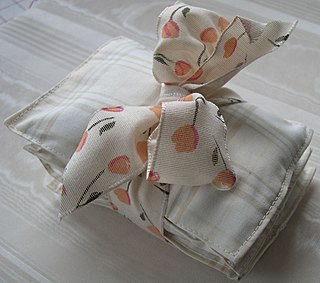This article needs additional citations for verification .(September 2014) |
Eye pillows, also known as dream pillows, are mask-shaped or rectangular pouches made from a fabric such as cotton or silk and filled with scented or non-scented herbs.
This article needs additional citations for verification .(September 2014) |
Eye pillows, also known as dream pillows, are mask-shaped or rectangular pouches made from a fabric such as cotton or silk and filled with scented or non-scented herbs.
At one time, eye pillows were called comfort pillows and were used in sick rooms to ease nightmares and to disguise the scent of illness. Herbs such as flax seed, lavender, chamomile, eucalyptus, and rose petals were used as fillers in eye pillows to help comfort the sick and ease them to sleep. Lavender is said to be a natural anti-depressant which helps in soothing insomnia, stress, and headaches. [1]

Eye pillows are typically used to shield the eyes from light and to apply a gentle, relaxing weight over and around the eyes. [1] They are also used to stimulate the oculocardiac reflex and lower the heart rate, [2] helping to activate the parasympathetic nervous system. [3]

Lavandula is a genus of 47 known species of perennial flowering plants in the mints family, Lamiaceae. It is native to the Old World, primarily found across the drier, warmer regions of mainland Eurasia, with an affinity for maritime breezes.

Thyme is a culinary herb consisting of the dried aerial parts of some members of the genus Thymus of flowering plants in the mint family Lamiaceae. Thymes are native to Eurasia and north Africa. Thymes have culinary, medicinal, and ornamental uses. The species most commonly cultivated and used for culinary purposes is Thymus vulgaris, native to SE Europe.

Contact lenses, or simply contacts, are thin lenses placed directly on the surface of the eyes. Contact lenses are ocular prosthetic devices used by over 150 million people worldwide, and they can be worn to correct vision or for cosmetic or therapeutic reasons. In 2010, the worldwide market for contact lenses was estimated at $6.1 billion, while the US soft lens market was estimated at $2.1 billion. Multiple analysts estimated that the global market for contact lenses would reach $11.7 billion by 2015. As of 2010, the average age of contact lens wearers globally was 31 years old, and two-thirds of wearers were female.

Ornamental plants or garden plants are plants that are primarily grown for their beauty but also for qualities such as scent or how they shape physical space. Many flowering plants and garden varieties tend to be specially bred cultivars that improve on the original species in qualities such as color, shape, scent, and long-lasting blooms. There are many examples of fine ornamental plants that can provide height, privacy, and beauty for any garden. These ornamental perennial plants have seeds that allow them to reproduce. One of the beauties of ornamental grasses is that they are very versatile and low maintenance. Almost all types of plant have ornamental varieties: trees, shrubs, climbers, grasses, succulents, aquatic plants, herbaceous perennials and annual plants. Non-botanical classifications include houseplants, bedding plants, hedges, plants for cut flowers and foliage plants. The cultivation of ornamental plants comes under floriculture and tree nurseries, which is a major branch of horticulture.

The vestibulo-ocular reflex (VOR) is a reflex that acts to stabilize gaze during head movement, with eye movement due to activation of the vestibular system, it is also known as the Cervico-ocular reflex. The reflex acts to stabilize images on the retinas of the eye during head movement. Gaze is held steadily on a location by producing eye movements in the direction opposite that of head movement. For example, when the head moves to the right, the eyes move to the left, meaning the image a person sees stays the same even though the head has turned. Since slight head movement is present all the time, VOR is necessary for stabilizing vision: people with an impaired reflex find it difficult to read using print, because the eyes do not stabilise during small head tremors, and also because damage to reflex can cause nystagmus.

A pillow is a support of the body at rest for comfort, therapy, or decoration. Pillows are used in different variations by many species, including humans. Some types of pillows include throw pillows, body pillows, decorative pillows, and many more. Pillows that aid sleeping are a form of bedding that supports the head and neck. Other types of pillows are designed to support the body when lying down or sitting. There are also pillows that consider human body shape for increased comfort during sleep. Decorative pillows used on beds, couches or chairs are sometimes referred to as cushions.

The human eye is an organ of the sensory nervous system that reacts to visible light and allows the use of visual information for various purposes including seeing things, keeping balance, and maintaining circadian rhythm.

Potpourri is a mixture of dried, naturally fragrant plant materials used to provide a gentle natural scent, commonly in residential settings. It is often placed in a decorative bowl.

Squinting is the action of looking at something with partially closed eyes.

Lavandula angustifolia, formerly L. officinalis, is a flowering plant in the family Lamiaceae, native to the Mediterranean. Its common names include lavender, true lavender and English lavender ; also garden lavender, common lavender and narrow-leaved lavender.
Child development stages are the theoretical milestones of child development, some of which are asserted in nativist theories. This article discusses the most widely accepted developmental stages in children. There exists a wide variation in terms of what is considered "normal", caused by variations in genetic, cognitive, physical, family, cultural, nutritional, educational, and environmental factors. Many children reach some or most of these milestones at different times from the norm.

The traditional kitchen garden, vegetable garden, also known as a potager or in Scotland a kailyaird, is a space separate from the rest of the residential garden – the ornamental plants and lawn areas. It is used for growing edible plants and often some medicinal plants, especially historically. The plants are grown for domestic use; though some seasonal surpluses are given away or sold, a commercial operation growing a variety of vegetables is more commonly termed a market garden. The kitchen garden is different not only in its history, but also its functional design. It differs from an allotment in that a kitchen garden is on private land attached or very close to the dwelling. It is regarded as essential that the kitchen garden could be quickly accessed by the cook.

' Merchandising is the practice in the retail industry of optimizing the presentation of products and services to better highlight their features and benefits.Then you have the purpose of

Thymus citriodorus, the lemon thyme or citrus thyme, is a lemon-scented evergreen mat-forming perennial plant in the family Lamiaceae. There has been a great amount of confusion over the plant's correct name and origin. Recent DNA analysis suggests that it is not a hybrid or cross, but a distinct species as it was first described in 1811., yet an analysis in a different study clustered Thymus citriodorus together with Thymus vulgaris, which is considered as one of its parent species.
Yusuf ibn Ismail al-Kutubi known as Ibn al-Kutbi a Persian scholar and physician worked as a doctor in the palaces of the Abbasid caliphs in Baghdad. He was born in Khoy in Iran.

A mattress pad, mattress topper, or underpad is designed to lie atop a mattress. Made from a variety of materials including wool, cotton, memory foam, feather and latex, its function is to provide an extra layer of comfort, especially when the existing mattress is worn or uncomfortable.
Cosmetics, first used in ancient Rome for ritual purposes, were part of daily life. Some fashionable cosmetics, such as those imported from Germany, Gaul and China, were so expensive that the Lex Oppia tried to limit their use in 189 BCE. These "designer brands" spawned cheap knock-offs that were sold to poorer women. Working-class women could afford the cheaper varieties, but may not have had the time to apply the makeup as the use of makeup was a time-consuming affair because cosmetics needed to be reapplied several times a day due to weather conditions and poor composition.

Although its most usual definition is that listed under "packet", a sachet can also mean a small scented cloth bag filled with herbs, potpourri, or aromatic ingredients; or a small porous bag or packet containing a material intended to interact with its atmosphere; for example, desiccants are usually packed in sachets which are then placed in larger packages.

Victorian-era cosmetics were cosmetic products used during the Victorian age. Victorian cosmetics sometimes used toxic ingredients such as lead, mercury, arsenic, and ammonia.

Vergence-accommodation conflict (VAC), also known as accommodation-vergence conflict, is a visual phenomenon that occurs when the brain receives mismatching cues between vergence and accommodation of the eye. This commonly occurs in virtual reality devices, augmented reality devices, 3D movies, and other types of stereoscopic displays and autostereoscopic displays. The effect can be unpleasant and cause eye strain.